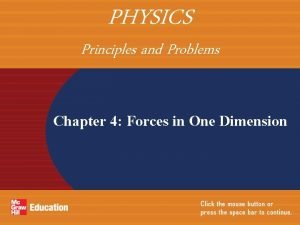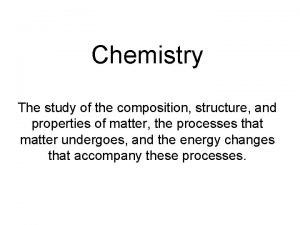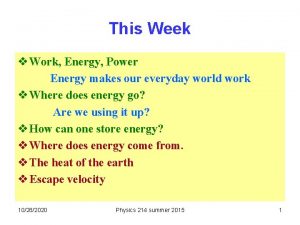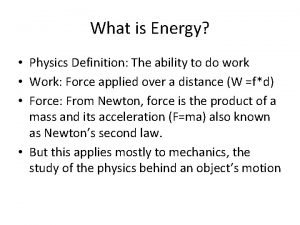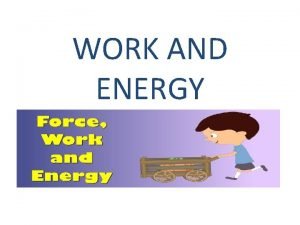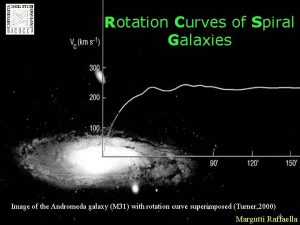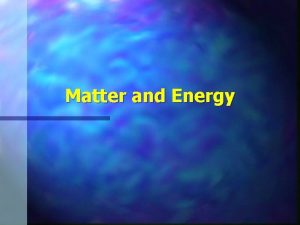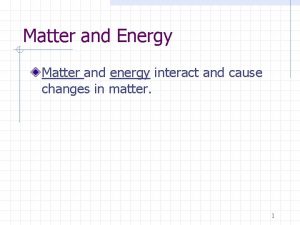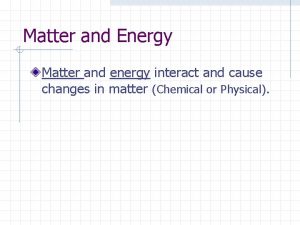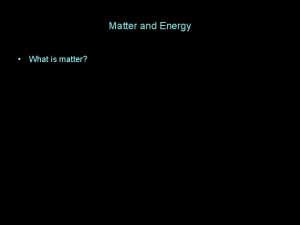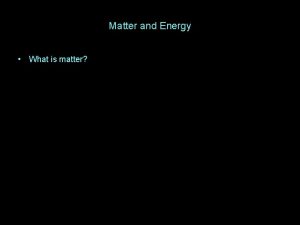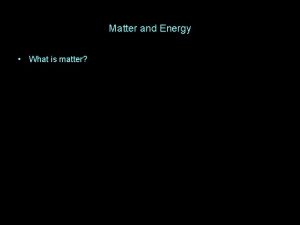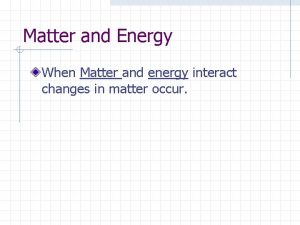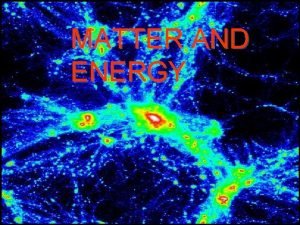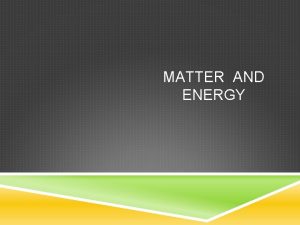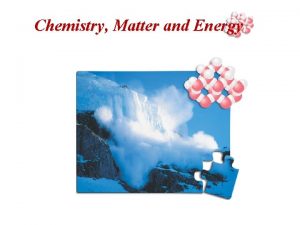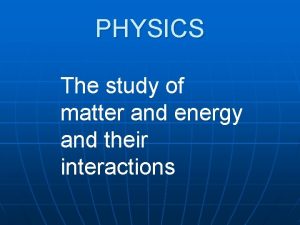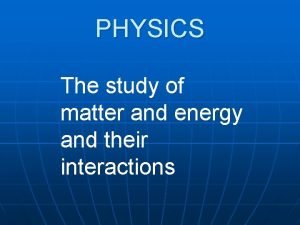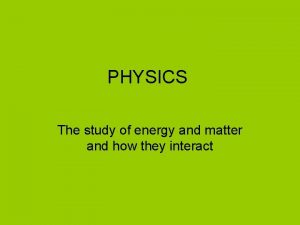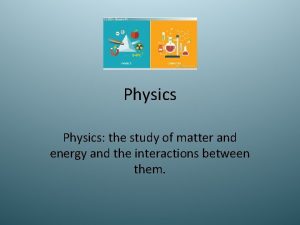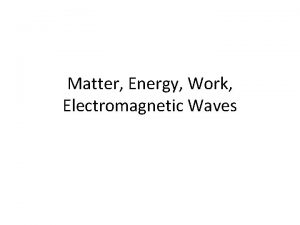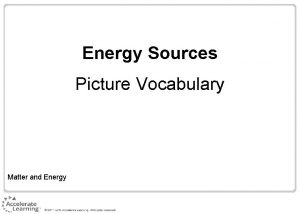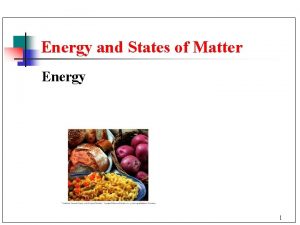Physics the study of matter and energy Matter









































- Slides: 41

Physics – the study of matter and energy.

Matter – Anything which occupies space, has substance, and under ordinary conditions cannot be created or destroyed. Solid, liquids, and gas are all examples of matter.

Solid – The only state of matter that has a definite shape and occupies a definite amount of space.

Atom – The most basic unit of a substance.

Molecules - Grouped of linked atoms.

Cohesion – The attraction that allows molecules of the same kind to stick together. Example – Molecules in a rock stuck together.

Adhesion – The attraction that allows molecules of a different kind to stick together. Example – The molecules of dry erase marker held to the white board.

Examples of adhesion involve two different things, examples of cohesion involve one thing.

Volume – The amount of substance a space occupies. To determine the volume of a rectangular solid, you need to know its length, width, and height. Units are cubed

Height = 1, 450 feet Length = 195 feet Width = 195 feet Volume = 55, 136, 250 feet 3


Volume = 549. 5 cm 3

Height = 672 feet Radius = 125 feet Volume = 32, 970, 000 feet 3

Height = 6 feet Length = 12 feet Width = 4 feet Volume = 288 feet 3

Height = 16 inches Radius = 8 inches Volume = 128 inches 3

Mass – The amount of material in an object. In other words, how much matter is in an object.

Weight – Is the measurement of the pull of gravity upon an object. Weight and mass are not the same, but are directly related to one another.

Density – Comparing the mass of objects with the same volume. Units are in g/cm 3

Volume = Mass/Density Mass = Volume X Density

Mass = 25. 0 grams Volume = 29. 4 cm 3 Density = 0. 850 g/cm 3

Mass = 425. 0 grams Volume = 48. 0 cm 3 Copper = 8. 85 g/cm 3 Bronze = 9. 87 g/cm 3 Gold = 19. 3 g/cm 3

Density = 7. 87 g/cm 3 Volume = 2500 cm 3 Mass = 19, 675 grams

Density = 19. 3 g/cm 3 Mass = 1500 grams Volume = 77. 7 cm 3

Mass = 75. 0 grams Volume = 56. 2 cm 3 Density = 1. 33 g/cm 3

Mass = 376. 0 grams Volume = 35. 8 cm 3 Steel = 7. 85 g/cm 3 Titanium = 4. 54 g/cm 3 Silver = 10. 5 g/cm 3

Density = 25. 87 g/cm 3 Volume = 5000 cm 3 Mass = 129, 350 grams

Density = 16. 3 g/cm 3 Mass = 1200 grams Volume = 73. 6 g/cm 3

Distance – The length of the path that something has traveled. Usually measured in meters or kilometers.

Speed - The distance covered by a moving object in a unit of time. Speed = Distance / Time

One day you decide to skateboard to the mall. It is 8 miles from your house to the mall and it takes you 1 hour to get to the mall. What is your average speed to the mall in MPH? 8 MPH

One day you decide to bike to school. It is 5 miles from your house to school and it takes you 30 minutes to get to school. What is your average speed to school in MPH? 10 MPH

One day you decide to run to the grocery school. It is 4 miles from your house to the grocery store and it takes you 40 minutes to get to the grocery store. What is your average speed to the store in MPH? 6 MPH

Velocity – The rate of motion (speed) in a particular direction. Velocity should always have a speed and a direction!

Uniform Motion – Motion in which the velocity of the moving object does not change.

Accelerated Motion - Motion in which the velocity of the moving object does change.

Acceleration – The change in velocity over a period of time. Acceleration = Final velocity – starting velocity / time Units usually in m/sec 2

Acceleration of Gravity – The type of acceleration experienced by falling objects.

Positive Acceleration – If the velocity of an object changes so its speed increases.

Negative Acceleration – If the velocity of an object changes so its speed decreases.

A man shoots an arrow at an initial velocity of 300 m/second in a vertical direction. When the arrow hits a tree its velocity is 100 m/second in a vertical direction. The arrow was in the air for 4 seconds. What was its rate of acceleration? -50 m/sec 2

A punter kicks a football at an initial velocity of 8 m/sec upward. The ball travels at this same velocity for 1. 5 seconds, how high did the punter kick the football? 12 m
 Whats the study of matter and energy
Whats the study of matter and energy Energy naturally flows from warmer matter to cooler matter
Energy naturally flows from warmer matter to cooler matter Energy energy transfer and general energy analysis
Energy energy transfer and general energy analysis Energy energy transfer and general energy analysis
Energy energy transfer and general energy analysis What is the difference between gray and grey
What is the difference between gray and grey Primary taste cortex
Primary taste cortex Gray matter and white matter
Gray matter and white matter Telecephalon
Telecephalon Chapter 4 study guide physics principles and problems
Chapter 4 study guide physics principles and problems Modern physics vs classical physics
Modern physics vs classical physics University physics with modern physics fifteenth edition
University physics with modern physics fifteenth edition Physics ib ia ideas
Physics ib ia ideas Study of the composition structure and properties
Study of the composition structure and properties Physics 03-06 impulse and momentum answer key
Physics 03-06 impulse and momentum answer key Work and energy physics
Work and energy physics Physic energy
Physic energy Physics 1
Physics 1 Work and energy physics
Work and energy physics Dark matter physics
Dark matter physics Hình ảnh bộ gõ cơ thể búng tay
Hình ảnh bộ gõ cơ thể búng tay Lp html
Lp html Bổ thể
Bổ thể Tỉ lệ cơ thể trẻ em
Tỉ lệ cơ thể trẻ em Voi kéo gỗ như thế nào
Voi kéo gỗ như thế nào Glasgow thang điểm
Glasgow thang điểm Hát lên người ơi alleluia
Hát lên người ơi alleluia Kể tên các môn thể thao
Kể tên các môn thể thao Thế nào là hệ số cao nhất
Thế nào là hệ số cao nhất Các châu lục và đại dương trên thế giới
Các châu lục và đại dương trên thế giới Công thức tính thế năng
Công thức tính thế năng Trời xanh đây là của chúng ta thể thơ
Trời xanh đây là của chúng ta thể thơ Mật thư anh em như thể tay chân
Mật thư anh em như thể tay chân 101012 bằng
101012 bằng Phản ứng thế ankan
Phản ứng thế ankan Các châu lục và đại dương trên thế giới
Các châu lục và đại dương trên thế giới Thể thơ truyền thống
Thể thơ truyền thống Quá trình desamine hóa có thể tạo ra
Quá trình desamine hóa có thể tạo ra Một số thể thơ truyền thống
Một số thể thơ truyền thống Cái miệng nó xinh thế chỉ nói điều hay thôi
Cái miệng nó xinh thế chỉ nói điều hay thôi Vẽ hình chiếu vuông góc của vật thể sau
Vẽ hình chiếu vuông góc của vật thể sau Thế nào là sự mỏi cơ
Thế nào là sự mỏi cơ đặc điểm cơ thể của người tối cổ
đặc điểm cơ thể của người tối cổ








